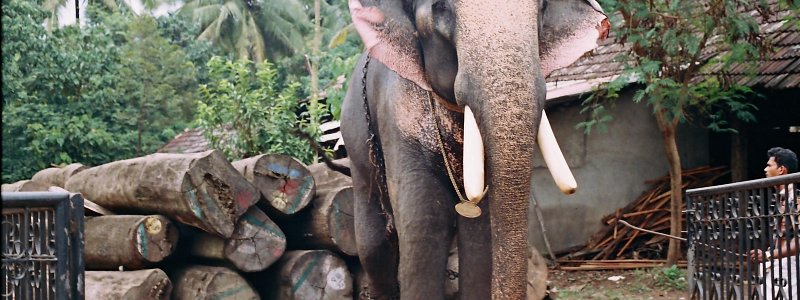Elephant - Symbol of Kerala
Our most beloved creature here in Kerala is also the symbol of the state: the elephant.
The most spectacular display of what Kipling called ‘the noble pachyderm’ takes place each May with the huge gathering of the Pooram Festival at Thrissur, Kerala’s cultural capital. In an eight day event flower-garlanded images of all the local gods are born on elephant back to gather in worship of Lord Shiva.
The climax is a coming together of splendidly caparisoned beasts, each bearing a brilliantly coloured ceremonial parasol, peacock fans and yak-tail fly-whisks. They amble regally from shrine to shrine in a musical procession, somehow smiling benignly through the din of the ear-splitting firework display that, as so often in India, is the culmination of the celebrations.
Between Thrissur and Neeleshwar rises the magnificent Krishna temple of Guruvayur which boasts a permanent stable of over fifty elephants from all over the country, all donated by devotees as a sign of piety. Here one can clearly spot the different characteristics of each regional breed - those from areas like Assam, for example, have shorter legs to enable them to keep their balance in the steep mountain terrain. Guruvayur’s elephants are used in the Krishna temple’s festivals and also rented out to other shrines all over the state for their own festivities. But once the busy festival months are over, the monsoon comes and its holiday time with some well-earned rest and serious pachyderm pampering.
As the tourists flee the rains and desert the Ayurvedic clinics, local elephants gleefully take their place. After months of walking on tarred roads, living on palm leaves and bananas and dignifying numerous temple festivals, their routine changes each July into a month-long rejuvenation treatment: individual examination, relaxing massages with medicinal oil, therapeutic baths, and sumptuous Ayurvedic meals that include rice mixed with ghee, wheat flour, powdered black pulses, palm sugar and various herbal powders mixed with vitamin and liver supplements. Presumably it is their unfailing memory of such lavish care that keeps the great beasts gently compliant throughout the following season. Fortunately, we humans can have good memories too.
In December 2011 the 35th death anniversary of a particularly loved temple elephant, Guruvayur Keshavan, was celebrated at the temple. A solemn procession of 24 tuskers, led by the senior member of the stable, Gajaratnam (‘Jewel among Elephants’) who carried a picture of the deceased, assembled in front of a statue of him. They stood with raised trunks for some time while floral tributes were laid. Keshavan was renowned for his majestic looks, intelligence and devotion to the image of the temple’s presiding deity.
Donated to Guruvayur by a local king in 1922, he served the temple for 54 years before dying on Ekadasi, a particularly auspicious day, in 1976. Three years previously he had formally been awarded the title of Gajarajan ‘King of Elephants’.





